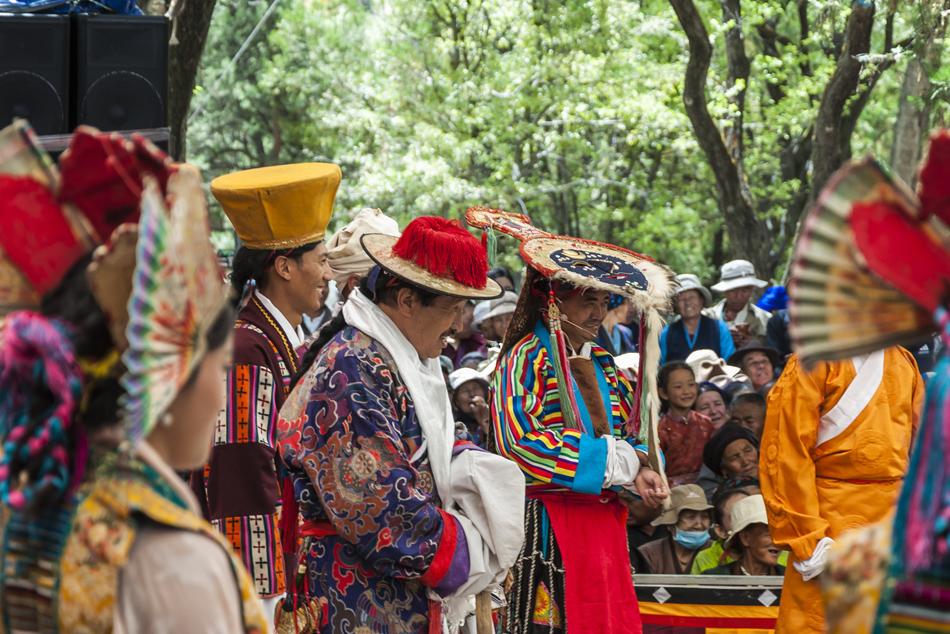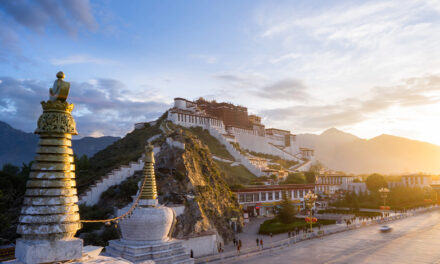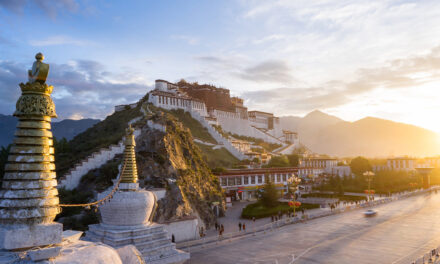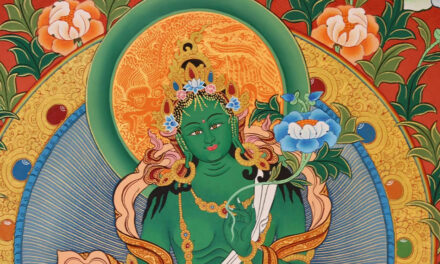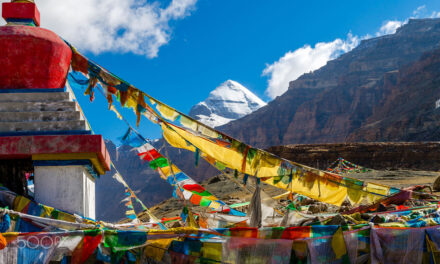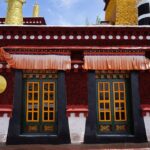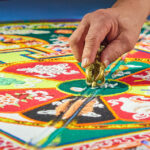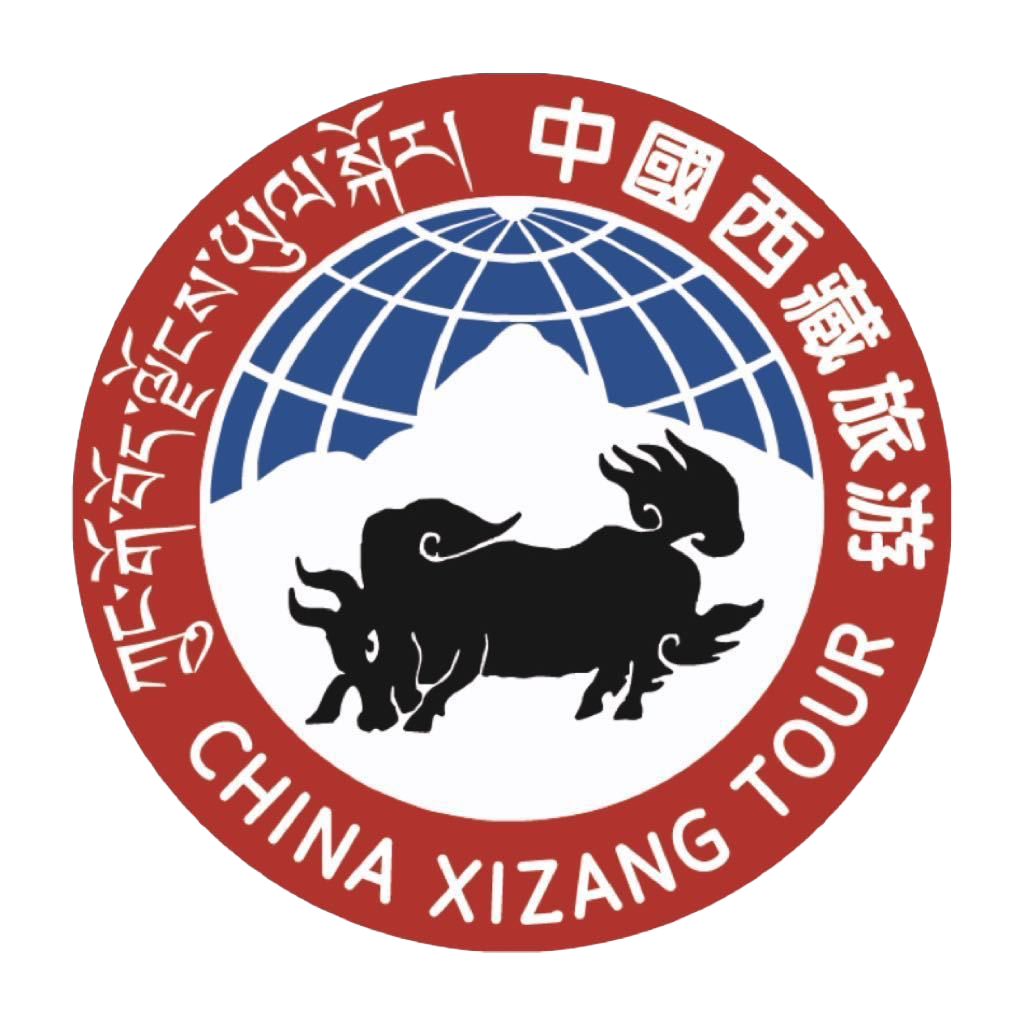Tibetan Opera, also known as Ache Lhamo, traces its origins to the remarkable life and vision of Thangtong Gyalpo, a 14th-century Tibetan yogi, scholar, and philanthropist. Born into a peasant family in Shigatse County in 1361, Thangtong Gyalpo’s journey from a monastery student to a bridge-building visionary laid the foundation for the unique and culturally rich form of expression that is Tibetan Opera.
Thangtong Gyalpo’s Motivations:
Thangtong Gyalpo’s journey towards Tibetan Opera was sparked by a deeply humane incident in Lhasa. Witnessing the struggle of people unable to afford boat crossings, he sought to alleviate their suffering by constructing bridges. However, his altruistic intentions were met with violence from boatmen. This experience fueled his determination to build bridges, both physical and metaphorical, for the benefit of his community.
Formation of the First Tibetan Opera Troupe:
During the construction of a bridge at Chowo Ri, Thangtong Gyalpo selected seven sisters who had worked diligently as laborers. These sisters became the cornerstone of the first Tibetan opera troupe. In their performances, they showcased not only their singing and dancing talents but also their commitment to Thangtong Gyalpo’s cause – raising funds for bridge construction projects. The girls, adorned in beautiful costumes, traveled across Tibet, captivating audiences with their performances.
Ache Lhasa – The Sister Goddesses:
The success of Thangtong Gyalpo’s troupe led to the sisters being revered as goddesses by the Tibetan people. They became known as Ache Lhasa, symbolizing the divine essence of their art. Over time, the entire Tibetan opera performance itself came to be referred to as Ache Lhamo, paying homage to the founding sisters and their profound impact on Tibetan culture.
Bridging Communities with Iron and Wooden Bridges:
Thangtong Gyalpo’s vision extended beyond the realm of art and performance. The funds raised through Ache Lhamo performances contributed to the construction of 58 iron bridges and 60 wooden bridges across Tibet. Some of these iron bridges still stand today, tangible reminders of the yogi’s dedication to improving the lives of his fellow Tibetans.
Cultural Customs and Rituals:
Thangtong Gyalpo’s influence extends beyond the physical bridges he built. In contemporary Tibet, it has become customary to install statues and images of the yogi when occupying a new home, symbolizing a connection to his spirit of compassion and community service. Additionally, during Tibetan opera performances, a ritual dance is incorporated, and statues of Thangtong Gyalpo are installed in the middle of the stage, emphasizing the ongoing homage paid to the visionary behind the art form.
Following are some of the most popular play in Tibetan Opera
1. The Brothers Donyo and Dondrup:
This enthralling tale transports us to the regal landscapes of ancient India, where the yearning of a pious king and queen for a son sets the stage for a narrative steeped in profound themes. As the tale unfolds, it becomes a captivating exploration of love, betrayal, and the transformative journey toward redemption, with a distinctive emphasis on Buddhist concepts that resonate throughout the storyline.
In the royal realms, the bond between Donyo and Dondrup, the two central characters, becomes the beating heart of the narrative. Their relationship is a testament to the enduring power of familial ties, echoing the deeply ingrained Tibetan cultural values that prioritize kinship and unity. The struggles and challenges faced by the brothers serve as a mirror reflecting the universal human experience, allowing audiences to connect with the characters on a personal and emotional level.
Buddhist principles thread seamlessly through the fabric of the narrative, weaving a tapestry of spiritual teachings and ethical considerations. The choices faced by the characters, their responses to adversity, and the moral dilemmas encountered are all framed within the context of Buddhist philosophy. The narrative becomes a vehicle for exploring concepts such as karma, compassion, and the path to enlightenment, elevating the story beyond mere entertainment to a realm of moral contemplation.
The story’s association with the Dalai Lamas and Panchen Lamas adds layers of significance, infusing the narrative with a sense of sacred continuity. It becomes not just a theatrical performance but a cultural repository, preserving the collective memory and spiritual heritage of the Tibetan people. Through the trials faced by Donyo and Dondrup, the audience is reminded of the resilience embedded in the Tibetan identity, drawing inspiration from the historical and spiritual lineage represented by these revered figures.
Central to the narrative is the profound theme of forgiveness, echoing the core tenets of Buddhist teachings. As the brothers navigate the complexities of their relationship, forgiveness emerges as a transformative force capable of healing wounds, fostering growth, and paving the way for redemption. The story becomes a parable on the redemptive power of compassion, urging the audience to reflect on their capacity for forgiveness and understanding.
In essence, “The Brothers Donyo and Dondrup” transcends its role as a mere opera, evolving into a narrative masterpiece that encapsulates the depth of Tibetan cultural values, spiritual wisdom, and the timeless universality of human experiences. Through the captivating interplay of characters and Buddhist themes, this opera invites audiences to embark on a journey of self-discovery, empathy, and the enduring quest for redemption.
2. Nangsa Obum:
Transporting us to the historical tapestry of 11th-century Tibet near the town of Gyangtsé, the operatic narrative of Nangsa Obum unfolds against a backdrop of cultural richness and spiritual depth. The central theme revolves around the internal conflict faced by Nangsa, a woman whose life becomes a poignant exploration of the delicate balance between spiritual devotion and societal expectations.
Nangsa’s character embodies the Tibetan ideal of dedicating oneself to the path of Dharma, reflecting the profound influence of Buddhism on the cultural ethos. Her struggles resonate with the universal human dilemma of navigating personal aspirations in the face of external pressures. The portrayal of her devotion to the Dharma, contrasted with the societal expectations thrust upon her, serves as a powerful metaphor for the perennial tug-of-war between individual spiritual quests and societal norms.
The storyline delves into the Tibetan belief in the possibility of returning to life after death, a concept deeply ingrained in the cultural and spiritual fabric of Tibetan Buddhism. This belief, often expressed through the notion of “death returners” (‘das log), adds a layer of mystique and hope to Nangsa’s journey. Her resilience in the face of challenges and her unwavering commitment to spiritual pursuits become a testament to the indomitable nature of the human spirit, even in the shadow of societal constraints.
The narrative unfolds against the backdrop of Gyangtsé, offering a glimpse into the historical and cultural context of 11th-century Tibet. The vivid portrayal of the landscape and the societal norms prevalent at the time provides the audience with a rich tableau against which Nangsa’s personal drama unfolds. The integration of historical elements adds depth to the storytelling, creating a tapestry that blends cultural authenticity with timeless themes.
Nangsa Obum, in its essence, becomes a narrative mirror reflecting the perennial human quest for meaning and the intricate dance between the spiritual and the worldly. It invites the audience to contemplate the delicate interplay between individual aspirations and societal expectations, a theme that resonates across cultures and epochs. Through Nangsa’s journey, the opera delivers a poignant message about the enduring power of spiritual resilience and the possibility of transcending societal constraints in the pursuit of a higher calling.
Finally, Nangsa Obum stands as a testament to the enduring cultural legacy of Tibet, weaving together elements of history, spirituality, and the human experience in a captivating operatic performance. The opera becomes not just a theatrical presentation but a cultural narrative that invites reflection on the timeless themes embedded in the Tibetan ethos.
3. Drime Kunden:
At the heart of Tibetan Opera, the narrative of Drime Kunden unfolds as a resounding allegory, echoing the profound virtues of selfless giving and altruism. This operatic tale traces the extraordinary journey of a prince, Drime Kunden, as he embarks on a path marked by unparalleled generosity and sacrifice, firmly rooted in the timeless wisdom of the Jataka tales.
The storyline of Drime Kunden draws inspiration from the Jataka tales, with a specific connection to the narrative of Prince Viśvantara. This ancient tale, attributed to the Buddha’s past lives, serves as a moral compass, illuminating the virtues of compassion and selflessness. Drime Kunden, as the protagonist, becomes a living embodiment of these virtues, navigating a narrative landscape where the act of giving transcends mere material wealth and extends into the realms of personal sacrifice.
The central theme revolves around the concept of selfless giving, where Drime Kunden’s character becomes a paragon of generosity. His willingness to relinquish everything he owns, including a wish-granting jewel crucial for the safety of his kingdom, underscores a profound commitment to the well-being of others. The narrative unfolds as a poignant exploration of the sacrificial nature of true altruism, emphasizing that genuine giving involves detachment from possessions and an unwavering commitment to the welfare of others.
As Drime Kunden is banished into exile with his family as a consequence of his actions, the opera delves into the complexities of virtue and sacrifice. The narrative compels the audience to reflect on the inherent challenges and consequences that often accompany acts of profound generosity. Drime Kunden’s exile becomes a crucible, testing the resilience of his commitment to selfless giving in the face of personal adversity.
The opera, through its rich storytelling, invites the audience to explore the deeper layers of generosity, moving beyond the material aspects to embrace the selflessness that defines true altruism. Drime Kunden’s journey becomes a universal parable, resonating across cultures and time periods, inviting contemplation on the transformative power of compassion and the enduring impact of selfless acts.
In conclusion, Drime Kunden emerges not only as an operatic performance but as a timeless narrative that transcends cultural boundaries. Rooted in ancient wisdom and moral teachings, the opera serves as a vessel carrying the profound message of selfless giving, a message that remains relevant and compelling in the contemporary tapestry of human experience. As the audience witnesses Drime Kunden’s journey, they are not merely spectators but participants in a narrative that beckons them to reflect on the boundless potential of altruism to shape and elevate the human spirit.
4. Drowa Sangmo:
Within the rich tapestry of Tibetan Opera, the narrative of Drowa Sangmo weaves a captivating tale that unfolds against the backdrop of celestial realms and humble beginnings in India. Born to parents of modest means, Drowa Sangmo emerges as a living embodiment of celestial energy, manifesting the essence of a ďākinī, or celestial being. This operatic story takes audiences on an unexpected journey through encounters with demons, cannibals, and, ultimately, the triumphant resilience of the human spirit.
The storyline of Drowa Sangmo introduces a central character whose celestial origins set the stage for a narrative that transcends the ordinary. Prophecies surrounding her birth foretell both extraordinary events and ominous challenges. As the tale unfolds, Drowa Sangmo’s life becomes entangled with the celestial and earthly, blurring the boundaries between the mystical and the mundane.
One of the distinctive features of this opera is its exploration of unexpected turns, where the protagonist faces encounters with demons and cannibals. These elements add layers of complexity to the narrative, showcasing the interplay between cosmic forces and earthly trials. Drowa Sangmo’s journey becomes a metaphor for the human experience, navigating through realms of darkness and uncertainty while embodying the innate capacity to triumph over adversity.
The narrative of Drowa Sangmo also holds connections to the tribal regions of Mön, providing a cultural anchor within the broader Tibetan landscape. The mention of Mön in the text suggests a bridge between the operatic storytelling tradition and the lived experiences of diverse communities. This connection enhances the narrative’s depth, offering glimpses into the cultural intersections that contribute to the rich mosaic of Tibetan heritage.
As Drowa Sangmo encounters challenges orchestrated by a demoness queen, the narrative unfolds into a complex tapestry of betrayal, survival, and transformation. Her journey, punctuated by the deceitful actions of the queen and the resilience of her spirit, becomes a metaphor for the enduring human capacity to navigate through life’s trials with grace and determination.
In conclusion, Drowa Sangmo stands as a testament to the versatility of Tibetan Opera in capturing not only celestial realms but also the complexities of earthly existence. Through its exploration of cultural connections and diverse landscapes, the opera becomes a mirror reflecting the rich tapestry of Tibetan heritage. Drowa Sangmo’s story, resonant with themes of celestial prophecy and triumph over adversity, invites audiences to contemplate the universal aspects of the human experience and the enduring spirit that transcends both celestial and earthly realms.
8. Pema Woaber:
In the intricate tapestry of Tibetan Opera, the narrative of Pema Woaber stands as a captivating journey deeply intertwined with the past incarnation of Padmasambhava. This operatic tale unfolds against a backdrop of impossible missions, perilous encounters with cannibals, and the transformative power of sacred mantras. Pema Öbar’s saga becomes a profound exploration of virtue, cosmic balance, and the eventual downfall of a fearful king.
The story commences in India, where a non-Buddhist king harbors a deep-seated fear that Sudhana, a prosperous merchant, might surpass him in wealth and influence. Motivated by this fear, the king subjects Sudhana to a seemingly insurmountable task – to retrieve a wish-fulfilling jewel hidden in the depths of the ocean. The journey takes an unforeseen turn when Sudhana’s boat is capsized by nāgas, aquatic serpent beings, leading to the capture of the entire crew by female cannibals who take them as husbands.
The narrative takes a perilous twist as Sudhana and his crew, inspired by the transformative power of mantras, manage to escape the clutches of the cannibals. The symbolic journey resonates with the Buddhist notion of overcoming obstacles through spiritual means, emphasizing the potency of inner strength and resilience.
Meanwhile, Sudhana’s wife miraculously gives birth to a son, believed to be an incarnation of the revered Indian yogi Padmasambhava. This divine child, named Pema Woaber, grows curious about his father’s fate. A twist of fate leads him to embark on a mission fraught with challenges, guided by a powerful mantra given by a dākini. This mantra, a recurring theme in Tibetan Opera, becomes a symbol of divine protection and guidance.
Throughout Pema Woaber journey, encounters with fierce cannibal women become allegorical representations of inner struggles and external threats. The transformative power of the mantra aids him in overcoming each obstacle, reinforcing the opera’s underlying themes of spiritual fortitude and the triumph of virtue over adversity.
As Pema Öbar returns triumphantly with the golden pan from the land of cannibals, the fearful king, now more anxious than ever, sends him on another mission. The king’s apprehension intensifies, leading to a sacrificial attempt on Pema Öbar’s life atop a high mountain. However, the narrative takes an unexpected turn as the dākinīs intervene, restoring Pema Öbar to life and orchestrating the downfall of the fearful king.
The narrative reaches its crescendo with the king and his ministers meeting a poetic justice – falling into the hands of the very cannibals they had sought to exploit. Pema Öbar emerges not only as a symbol of virtue and resilience but also as a harbinger of justice, balancing the cosmic scales in the face of tyranny.
In conclusion, Pema Woaber tale within Tibetan Opera unfolds as an intricate dance of cosmic forces, virtues, and transformative power. The narrative, rich with symbolism and spiritual allegory, invites audiences to contemplate the profound themes of resilience, justice, and the enduring triumph of virtue in the face of fear and adversity. The opera’s resonance extends beyond its temporal and cultural context, offering timeless insights into the human spirit’s capacity for transformation and the cosmic balance that guides the destiny of its protagonists.
Yoghurt Festival and Tibetan Opera:
At the heart of Tibetan cultural celebrations lies the Yoghurt Festival, an integral occasion that frequently aligns with the mesmerizing performances of Tibetan Opera. This festival, locally referred to as “Drowa Sangmo” in Tibetan, transcends a mere culinary event to become a symbolic convergence of tradition, spirituality, and communal unity. The Yoghurt Festival is a vibrant tapestry interwoven with the offering and consumption of yoghurt, signifying purity and auspiciousness in the rich cultural mosaic of Tibet.
The Yoghurt Festival, with its resonant cultural significance, frequently coincides with the spirited performances of Tibetan Opera. This synchronicity creates a harmonious blend of sensory experiences, where the visual allure of the opera converges with the delectable taste of yoghurt, creating a holistic celebration for the community.
The festival, marked by the sharing and partaking of yoghurt, extends beyond its culinary dimension. Yoghurt, in Tibetan culture, is emblematic of purity and good fortune. Its inclusion in the festival’s rituals serves as a ceremonial offering, symbolizing blessings for the community and invoking positive energies for the times ahead. This act of shared consumption becomes a communal affirmation of prosperity, health, and collective well-being.
As communities gather to indulge in the creamy richness of yoghurt, the backdrop of Tibetan Opera adds an extra layer of cultural depth to the festivities. Tibetan Opera, with its roots deeply embedded in the cultural and spiritual heritage of Tibet, becomes a living expression of the community’s narrative, values, and shared identity.
The synergy between the Yoghurt Festival and Tibetan Opera extends beyond mere coincidence. Both cultural phenomena converge to create an immersive experience that resonates with the soul of Tibet. The vibrant colors, intricate costumes, and rhythmic melodies of the opera intertwine with the luscious taste of yoghurt, creating a multisensory celebration that engages the community on profound levels.
Beyond the surface-level revelry, the Yoghurt Festival and Tibetan Opera serve as conduits for the preservation and transmission of Tibetan cultural heritage. The opera, with its narratives rooted in historical events, mythologies, and Buddhist teachings, becomes a living repository of the community’s collective memory. The festival, occurring in tandem, becomes a dynamic platform for cultural continuity, fostering a sense of shared heritage among generations.
In essence, the Yoghurt Festival and Tibetan Opera form a symbiotic relationship, each enhancing the other’s significance. The festival infuses the opera performances with an added layer of cultural context, while the opera, in turn, elevates the festival from a culinary event to a cultural spectacle. Together, they create an immersive experience that not only delights the senses but also reinforces the bonds of community, identity, and the enduring spirit of Tibet.
Conclusion of Tibetan Opera
In conclusion, Tibetan opera stands as a testament to the enduring spirit of Tibetan culture, embodying its myths, spiritual teachings, and historical narratives. These operas not only entertain but also serve as conduits for transmitting values and preserving the unique heritage of the Tibetan people. The Yoghurt Festival, with its connection to opera performances, further enhances the cultural significance of these artistic expressions, fostering a deep sense of community and continuity.

